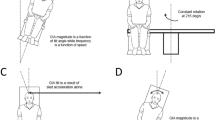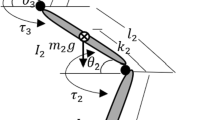Abstract
The vestibular system is thought to influence human postural control both by means of direct effects on motoneurons and by indirect interactions with somatosensory reflexes. Experimental investigation of vestibulospinal effects therefore requires the independent, dynamic manipulation of both somatosensory and vestibular inputs. The paper describes a system developed to provide this capability for human studies. It consists of a tilt table, whose angle of tilt is controlled by a linear hydraulic actuator, on which is mounted a rotary hydraulic actuator. Subjects are strapped to the table with the left foot connected to the rotary actuator. Both actuators are operated as position servos, allowing vestibular input to be controlled by dynamically varying the table's angle of tilt and somatosensory input to be controlled by manipulating the angular position of the ankle with the rotary actuator. The ankle actuator has a frequency response which is flat up to 25 Hz but can apply stimuli with power adequate for system identification purposes to more than 50 Hz. Similarly, the table frequency response is flat to 3 Hz but generates inputs containing significant power up to 15 Hz. The independent dynamic control of both vestibular and somatosensory inputs afforded by the tilt-table/ankle-actuator device makes possible the application of multiple input/output engineering systems analysis techniques.
Similar content being viewed by others
References
Anderson, J. H., Soechting, J. F. andTerzuolo, C. A. (1977a) Dynamic relations between natural vestibular inputs and activity of forelimb extensor muscles in the decerebrate cat. I. Motor output during sinusoidal linear accelerations.Brain Res.,120, 1–15.
Anderson, J. H., Soechting, J. F. andTerzuolo, C. A. (1977b) Dynamic relations between natural vestibular inputs and activity of forelimb extensor muscles in the decerebrate cat. II. Motor output during rotations in the horizontal plane.—ibid.,120, 17–33.
Chan, C. W. Y. andKearney, R. E. (1983) Influence of tonic labyrinth reflex upon soleus motoneuron excitability in man.Neuroscience Letters, (in press).
Chan, C. W. Y., Kearney, R. E. andMelvill Jones, G. (1979) Tibialis anterior response to sudden ankle displacements in normal and Parkinsonian subjects.Brain Res.,173, 303–314.
Delwaide, P. J. andJuprelle, M. (1977) The effects of caloric stimulation of the labyrinth on the soleus motor pool in man.Acta Neurol. Scandinav.,55, 310–322.
Goldberg, J. M. (1979) Vestibular receptors in mammals: afferent discharge characteristics and efferent control. InReflex control of posture and movement,Granit,R. andPompeiano,O. (eds.), (Prog. Brain. Res.,50, 355–367), Elsevier/North Holland, Amsterdam.
Greenwood, R. andHopkins, A. (1976) Muscle responses during sudden falls in man.J. Physiol.,254, 507–518.
Hunter, I. W. andKearney, R. E. (1982) Dynamics of human ankle stiffness: variation with mean ankle torque.J. Biomechanics,15, 747–757.
Katsarkas, A. andOuterbridge, J. S. (1981) Compensation of unilateral vestibular loss in vestibular neuronitis.Ann. N.Y. Acad. Sci.,374, 784–793.
Kearney, R. E. andChan, C. W. Y. (1982) Contrasts between the reflex responses of tibialis anterior and triceps surae to sudden ankle rotation in normal human subjects.Electroenceph. Clin. Neurophysiol.,54, 301–310.
Kearney, R. E. andHunter, I. W. (1982) Dynamics of human ankle stiffness: variation with displacement amplitude.J. Biomechanics,15, 753–756.
Lindsay, K. W., Roberts, T. D. M. andRosenberg, J. R. (1976) Asymmetric tonic labyrinth reflexes and their interaction with neck reflexes in the decerebrate cat.J. Physiol.,261, 583–601.
Matthews, P. B. C. (1972)Mammalian muscle receptors and their central actions. Edward Arnold Ltd., London.
Melvill Jones, G. andWatt, D. G. D. (1971) Muscular control of landing from unexpected falls in man.J. Physiol.,219, 729–737.
Merritt, H. E. (1967)Hydraulic control systems. Wiley & Sons, New York.
Money, K. E. andScott, J. W. (1962) Functions of separate sensory receptors of non-auditory labyrinth of the cat.Am. J. Physiol.,202, 121–1220.
Nashner, L. M., Black, F. O. andWall, C. (1982) Adaptation to altered support and visual conditions during stance: patients with vestibular deficits.J. Neurosci.,2, 536–544.
Nashner, L. M. andWolfson, P. (1974) Influence of head position and proprioceptive cues on short latency postural reflexes evoked by galvanic stimulation of the human labyrinth.Brain Res.,67, 255–268.
Schor, R. H. andMiller, A. D. (1981) Vestibular reflexes in neck and forelimb muscles evoked by roll tilt.J. Neurophysiol.,46, 167–178.
Soechting, J. F. andRoberts, W. J. (1975) Transfer characteristics between EMG activity and muscle tension under isometric conditions in man.J. Physiol. (Paris) 70, 779–793.
Stein, R. B. (1974) Peripheral control of movement.Physiol. Rev.,54, 215–243.
Watt, D. G. D. (1976) Responses of cats to sudden falls: an otolith-originating reflex assisting landing.J. Neurophysiol.,39, 257–265.
Watt, D. G. D. (1981a) Effect of vertical linear acceleration on H-reflex in decerebrate cat. I. Transient stimuli.—ibid.,,45, 644–655.
Watt, D. G. D. (1981b) Effect of vertical linear acceleration on H-reflex in decerebrate cat. II. Sinusoidal stimuli.—ibid.,,45, 656–666.
Wilson, V. andMelvill Jones, G. (1979)Mammalian vestibular physiology. Plenum Press, New York.
Author information
Authors and Affiliations
Rights and permissions
About this article
Cite this article
Kearney, R.E., Hunter, I.W., Weiss, P.L. et al. Tilt-table/ankle-actuator system for the study of vestibulospinal reflexes. Med. Biol. Eng. Comput. 21, 301–305 (1983). https://doi.org/10.1007/BF02478498
Received:
Issue Date:
DOI: https://doi.org/10.1007/BF02478498




